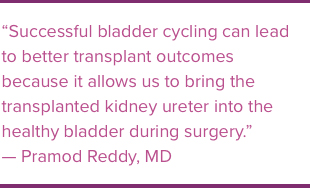Bladder Cycling Therapy Can Help Improve Kidney Transplant Outcomes

The painstaking process of bladder cycling can lead to optimal kidney transplant outcomes for babies with congenital malformations of the lower urinary tract. Now that more of these babies are surviving to delivery and being evaluated for transplantation, the therapy is more vital than ever.
Cincinnati Children’s is one of only a few pediatric institutions in the country to offer bladder cycling in order to rehabilitate the bladder and restore/regain function and capacity. Most referrals come from the Cincinnati Children's Fetal Care Center, a collaboration with TriHealth and UC Health that provides comprehensive care for expectant moms who have a baby with known medical conditions.
“We have been doing bladder cycling for several years,” says Pramod Reddy, MD, director of the Division of Pediatric Urology. “Recently we expanded our inclusion criteria, thanks to our partnership with the Fetal Care Center and collaboration with our pediatric nephrologists, who can offer dialysis for babies weighing as little as 5 pounds.”

Bladder cycling is used for children born with posterior urethral valves, urethral atresia, renal agenesis or multicystic dysplastic kidneys who are candidates for kidney transplantation. These babies may have an underdeveloped bladder or a bladder that developed correctly but didn’t grow in utero as their kidneys failed to develop, preventing urine production and inhibiting bladder growth.
Bladder cycling trains and progressively stretches the underdeveloped small bladder in weeks or months. Pediatric urologists initiate bladder cycling to:
- Help the bladder achieve normal size and physiological function
- Avoid the bladder pathology that may have contributed to the injury of the child’s own kidneys
- Protect the child’s native kidney or future transplanted kidney from ongoing injury
Bladder cycling involves catheterizing the child’s bladder and instilling a solution of saline and antibiotic several times a day. Parents learn how to catheterize their child at home; a suprapubic catheter is utilized if the urethra is not accessible. Ideally the child will void on their own. If not, the catheter is clamped and unclamped as needed. If the child tolerates the therapy, 3-5 ml is added to the volume of the solution every few days. Medication, including Botox, can facilitate bladder remodeling and enhance stretching. Each week, the goal is to add 5-10 ml of bladder capacity.
“Successful bladder cycling can lead to better transplant outcomes because it allows us to connect the ureter of the transplanted kidney into a healthy bladder during surgery,” Reddy says. “In some situations, we may augment the bladder prior to kidney transplant by enlarging it with a piece of intestine. Otherwise, we have to divert the ureter out to the skin during transplant and plan for an undiversion surgery when the child is older.”
The pediatric urology team at Cincinnati Children’s has done bladder cycling for at least 10 babies in last three years, with a 70% success rate in conditioning the bladder for a kidney transplant. Recently they adapted a care protocol for those born without kidneys, whose bladder capacity can be as low as 5 ml. It is based on the work of Douglas Canning, MD, at Children's Hospital of Philadelphia.
For more information or to make a referral, contact Pramod.Reddy@cchmc.org.

